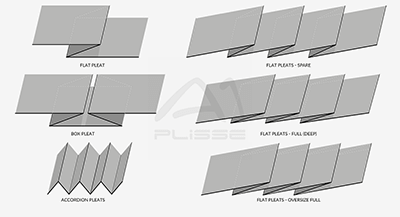
Machine pleating
Introduction

Selected pleat types
Machine pleating is a process, where fabric is shaped by folding fabric (this process is done by two special knifes in pleating machine) and then fixed using high temperature. This type of fabric folding is called a pleat, hence the name of the process. There are several basic types of machine pleating: pleats based on flat (knife) pleat, fancy pleats (Harlequin, Wave, 'Fir'), accordion pleats.
Flat pleats
One of the most popular types of machine pleating. The base pattern is in the form of repeated pleats of fixed length, but it is also possible to get more sophisticated pleats. Depending on the pattern the pleats may vary their length, insert spacing or box pleats, while maintaining the perfect repeatability of pleats even at very small sizes. An interesting example of more advanced machine pleating contains of a few pleats, that are placed e.g. exactly in the middle of the pre-cut element, leaving the rest of fabric untouched. We also offer pleating only part of the fabric (so that e.g. the bottom part of skirt remains unpleated) and possibilities of combining various types of pleating.
Printing on pleated fabric
We offer the service of printing full colour designs on fabric printed in our company. As a result of this process, the fabric is only covered with design on the visible parts of pleats and remains unpainted on the other parts. In combination with interesting patterns from our catalogue this technique allows to achieve amazing three-dimensional effects.
Fancy pleats
Constantly expanded and modernized machine park allows us to introduce new models to our offer, also in machine pleating. We offer both classic fancy designs, like 'fir', wave or crystal, as well as modular solutions such as Harlequin, all with a wide range of customization.
Accordion pleats
Accordion pleating is a special type of machine pleating, in which the fabric is shaped like accordion (both sides of fold are equal). In this pleating type we offer several unique variants, including the possibility of obtaining two pleat heights next to each other. Special solutions, that we've developed over the years, allow us also to use this type of pleating only on part of the fabric (same as with flat pleats), even on previously flat pleated fabric.